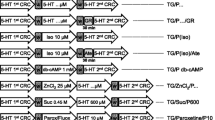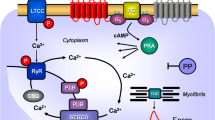Abstract
Cisapride and prucalopride act as 5-HT4 receptor agonists. As a part of our ongoing effort to study the utility of a transgenic (TG) mouse model overexpressing cardiac 5-HT4 receptors, we assessed the extent to which we could recapitulate cisapride and prucalopride agonists. Contractile studies were performed using isolated left and right atrial preparations of TG mice showing cardiac-specific human 5-HT4a receptor expression and those of their wild-type (WT) littermates. 5-Hydroxytryptamine (5-HT), cisapride, and prucalopride exerted concentration-dependent positive inotropic effects in the left atrial preparations of TG mice. Moreover, 5-HT induced concentration-dependent arrhythmias in the right atrial preparations of TG mice starting from 10-nM concentration. However, cisapride induced arrhythmias not only in the right atrial preparations of TG mice but also in the right atrial preparations of WT mice. For instance, 10 μM cisapride induced arrhythmias in the right atrial preparations of TG and WT mice to the same extent. Prucalopride did not exert concentration-dependent proarrhythmic effects in the isolated atrial preparations (left or right, WT or TG). Furthermore, cisapride and prucalopride increased the contractility and beating rate in vivo in TG mice, as assessed by performing echocardiography and surface electrocardiography. In summary, our results indicate that cisapride and prucalopride increase contractility and beating rate in the isolated atrial preparations of TG mice or in intact TG mice. Moreover, 5-HT induced arrhythmias in the isolated right atrial preparations of TG mice in a concentration-dependent manner. Furthermore, cisapride induced arrhythmias in the isolated right atrial preparations of both TG and WT mice. In contrast, prucalopride did not induce arrhythmias in the atrial preparations (left or right) of both WT and TG mice. We suggest that the present TG mouse model might be useful to predict at least some important cardiac effects of 5-HT4 receptor agonists in the human heart.




Similar content being viewed by others
References
Bach T, Syversveen T, Kvingedal AM, Krobert KA, Brattelid T, Kaumann AJ, Levy FO (2001) 5HT4(a) and 5-HT4(b) receptors have nearly identical pharmacology and are both expressed in human atrium and ventricle. Naunyn Schmiedeberg’s Arch Pharmacol 363:146–160
Bateman DN (1986) The action of cisapride on gastric emptying and the pharmacodynamics and pharmacokinetics of oral diazepam. Eur J Clin Pharmacol 30:205–208
Blondel O, Vandecasteele G, Gastineau M, Leclere S, Dahmoune Y, Langlois M, Fischmeister R (1997) Molecular and functional characterization of a 5-HT4 receptor cloned from human atrium. FEBS Lett 412:465–474. https://doi.org/10.1016/S0014-5793(97)00820-X
Brattelid T, Kvingedal AM, Krobert KA, Andressen KW, Bach T, Hystad ME, Kaumann AJ, Levy FO (2004) Cloning, pharmacological characterisation and tissue distribution of a novel 5-HT4 receptor splice variant, 5-HT4(i). Naunyn Schmiedeberg’s Arch Pharmacol 369:616–628. https://doi.org/10.1007/s00210-004-0919-4
Briejer MR, Bosmans JP, Van Daele P, Jurzak M, Heylen L, Leysen JE, Prins NH, Schuurkes JA (2001) The in vitro pharmacological profile of prucalopride, a novel enterokinetic compound. Eur J Pharmacol 423:71–83. https://doi.org/10.1016/S0014-2999(01)01087-1
Camilleri M, Beyens G, Kerstens R, Robinson P, Vandeplassche L (2009) Safety assessment of prucalopride in elderly patients with constipation: a double-blind, placebo-controlled study. Neurogastroenterol Motil 21:1256–e117. https://doi.org/10.1111/j.1365-2982.2009.01398.x
Chai W, Chan KY, de Vries R, van den Bogeardt AJ, de Maeyer JH, Schuurkes JA, Villalón CM, Saxena PR, Danser AH, Maassen Van Den Brink A (2012) Inotropic effects of prokinetic agents with 5-HT(4) receptor agonist actions on human isolated myocardial trabeculae. Life Sci 90:538–544. https://doi.org/10.1016/j.lfs.2012.01.009
De Maeyer JH, Prins NH, Schuurkes JA, Lefebvre RA (2006) Differential effects of 5-hydroxytryptamine4 receptor agonists at gastric versus cardiac receptors: an operational framework to explain and quantify organ-specific behavior. J Pharmacol Exp Ther 317:955–964. https://doi.org/10.1124/jpet.106.101329
Gergs U, Neumann J, Simm A, Silber RE, Remmers FO, Läer S (2009) Phosphorylation of phospholamban and troponin I through 5-HT4-receptors in the isolated human atrium. Naunyn Schmiedeberg’s Arch Pharmacol 379:349–359. https://doi.org/10.1007/s00210-008-0371-y
Gergs U, Baumann M, Böckler A, Buchwalow IB, Ebelt H, Fabritz L, Günther S, Hauptmann S, Kirchhof P, Klöckner U, Pönicke K, Rückschloß U, Schmitz W, Schulz N, Werner F, Neumann J (2010) Cardiac overexpression of the human 5-HT4-receptor in mice. Am J Physiol Heart Circ Physiol 299:H788–H798. https://doi.org/10.1152/ajpheart.00691.2009
Gergs U, Böckler A, Ebelt H, Hauptmann S, Keller N, Otto V, Pönicke K, Schmitz W, Neumann J (2013) Human 5-HT4 receptor stimulation in atria of transgenic mice. Naunyn Schmiedeberg’s Arch Pharmacol 386:357–367. https://doi.org/10.1007/s00210-013-0831-x
Gergs U, Fritsche J, Fabian S, Christ J, Neumann J (2017a) Desensitization of the human 5-HT4 receptor in isolated atria of transgenic mice. Naunyn Schmiedeberg’s Arch Pharmacol 390:987–996. https://doi.org/10.1007/s00210-017-1403-2
Gergs U, Jung F, Buchwalow IB, Hofmann B, Simm A, Treede H, Neumann J (2017b) Pharmacological and physiological assessment of serotonin formation and degradation in isolated preparations from mouse and human heart. Am J Physiol Heart Circ Physiol 313:H1087–H1097. https://doi.org/10.1152/ajpheart.00350.2017
Hollander W, Michelson AL, Wilkins RW (1957) Serotonin and antiserotonins. I. Their circulatory, respiratory, and renal effects in man. Circulation 16:246–255. https://doi.org/10.1161/01.CIR.16.2.246
Jahnel U, Rupp J, Ertl R, Nawrath H (1992) Positive inotropic response to 5-HT in human atrial but not in ventricular heart muscle. Naunyn Schmiedeberg’s Arch Pharmacol 346:482–485
Jahnel U, Nawrath H, Rupp J, Ochi R (1993) L-type calcium channel activity in human atrial myocytes as influenced by 5-HT. Naunyn Schmiedeberg’s Arch Pharmacol 348:396–402
Kaumann AJ (1990) Piglet sinoatrial receptors resemble human atrial 5-HT4-like receptors. Naunyn Schmiedeberg’s Arch Pharmacol 342:619–622
Kaumann AJ (1994) Do human atrial 5-HT4 receptors mediate arrhythmias? Trends Pharmacol Sci 15:451–455
Kaumann AJ, Levy FO (2006) 5-Hydroxytryptamine receptors in the human cardiovascular system. Pharmacol Ther 111:674–706
Kaumann AJ, Sanders L (1994) 5-Hydroxytryptamine causes rate-dependent arrhythmias through 5-HT4 receptors in human atrium: facilitation by chronic β-adrenoceptor blockade. Naunyn Schmiedeberg’s Arch Pharmacol 349:331–337
Kaumann AJ, Sanders L, Brown AM, Murray KJ, Brown MJ (1990) A 5-hydroxytryptamine receptor in human atrium. Br J Pharmacol 100:879–885. https://doi.org/10.1111/j.1476-5381.1990.tb14108.x
Kaumann AJ, Sanders L, Brown AM, Murray KJ, Brown MJ (1991) A 5-HT4-like receptor in human right atrium. Naunyn Schmiedeberg’s Arch Pharmacol 344:150–159
Keller N, Gergs U, Neumann J (2010) Cisapride in 5HT4-receptor overexpressing mice. Naunyn-Schmiedeberg’s Arch Pharmacol 381(Suppl. 1):51
Keller N, Gergs U, Dhein S, Neumann J (2012) Effects of prucalopride in 5-HT4a receptor overexpressing mice. Naunyn-Schmiedeberg’s Arch Pharmacol 385(Suppl 1):S44
Kirchhefer U, Baba HA, Hanske G, Jones LR, Kirchhof P, Schmitz W, Neumann J (2004) Age-dependent biochemical and contractile properties in atrium of transgenic mice overexpressing junctin. Am J Physiol Heart Circ Physiol 287:H2216–H2225. https://doi.org/10.1152/ajpheart.00137.2004
Krobert KA, Brattelid T, Levy FO, Kaumann AJ (2005) Prucalopride is a partial agonist through human and porcine atrial 5-HT4 receptors: comparison with recombinant human 5-HT4 splice variants. Naunyn Schmiedeberg’s Arch Pharmacol 371:473–479. https://doi.org/10.1007/s00210-005-1068-0
Langlois M, Fischmeister R (2003) 5-HT4 receptor ligands: applications and new prospects. J Med Chem 46:319–344
Mendzelevski B, Ausma J, Chanter DO, Robinson P, Kerstens R, Vandeplassche L, Camm J (2011) Assessment of the cardiac safety of prucalopride in healthy volunteers: a randomized, double-blind, placebo- and positive-controlled thorough QT study. Br J Clin Pharmacol 73:203–209. https://doi.org/10.1111/j.1365-2125.2011.04088.x
Mohammad S, Zhou Z, Gong Q, January CT (1997) Blockage of the HERG human cardiac K+ channel by the gastrointestinal prokinetic agent cisapride. Am J Phys 273:H2534–H2538
Neumann J, Boknik P, Matherne GP, Lankford A, Schmitz W (2003) Pertussis toxin sensitive and insensitive effects of adenosine and carbachol in murine atria overexpressing A1–adenosine receptors. Br J Pharmacol 138:209–217. https://doi.org/10.1038/sj.bjp.070501
Neumann J, Keller N, Gergs U (2012) Initial characterisation of mice with heart specific overexpression of 5 HT4 receptors. Biochem Soc Trans 41(Part 1):P024, S19
Neumann J, Hofmann B, Gergs U (2017) Production and function of serotonin in cardiac cells. Serotonin—a chemical messenger between all types of living cells, Chapter 13; 271–305 ISBN 978-953-51-3361-2 Kaneez Fatima Shad (ed)
Olsson S, Edwards IR (1992) Tachycardia during cisapride treatment. BMJ 305:748–749
Pau D, Workman AJ, Kane KA, Rankin AC (2005) Electrophysiological effects of prucalopride, a novel enterokinetic agent, on isolated atrial myocytes from patients treated with beta-adrenoceptor antagonists. J Pharmacol Exp Ther 313:146–153. https://doi.org/10.1124/jpet.104.076869
Pino R, Cerbai E, Calamai G, Alajmo F, Borgioli A, Braconi L, Cassai M, Montesi GF, Mugelli A (1998) Effect of 5-HT4 receptor stimulation on the pacemaker current I(f) in human isolated atrial myocytes. Cardiovasc Res 40:516–522
Pönicke K, Gergs U, Buchwalow IB, Hauptmann S, Neumann J (2012) On the presence of serotonin in mammalian cardiomyocytes. Mol Cell Biochem 365:301–312. https://doi.org/10.1007/s11010-012-1270-6
Robiolio PA, Rigolin VH, Wilson JS, Harrison JK, Sanders LL, Bashore TM, Feldman JM (1995) Carcinoid heart disease. Correlation of high serotonin levels with valvular abnormalities detected by cardiac catheterization and echocardiography. Circulation 92:790–795. https://doi.org/10.1161/01.CIR.92.4.790
Sanders L, Kaumann AJ (1992) A 5-HT4-like receptor in human left atrium. Naunyn Schmiedeberg’s Arch Pharmacol 345:382–386
Sanders L, Lynham JA, Bond B, del Monte F, Harding S, Kaumann AJ (1995) Sensitization of human atrial 5-HT4 receptors by chronic β-blocker treatment. Circulation 92:2526–2539. https://doi.org/10.1161/01.CIR.92.9.2526
Sanger GJ (2009) Translating 5-HT receptor pharmacology. Neurogastroenterol Motil 21:1235–1238. https://doi.org/10.1111/j.1365-2982.2009.01425.x
Saxena PR, Villalon CM (1991) 5-Hydroxytryptamine: a chameleon in the heart. Trends Pharmacol Sci 12:223–227
Schoemaker RG, Du XY, Bax WA, Saxena PR (1992) 5-Hydroxytryptamine increases contractile force in porcine right atrium but not in left ventricle. Naunyn Schmiedeberg’s Arch Pharmacol 346:486–489
Verbeuren TJ (1990) The distribution and biochemistry of 5-HT in the cardiovascular system. In: Saxena PR, Wallis DI, Wouters W, Bevan P (eds) Cardiovascular pharmacology of 5-hydroxytryptamine. Kluwer, Dordrecht, pp 3–13
Verbeuren TJ (1992) 5-Hydroxytryptamine: distribution, synthesis, metabolism, release, uptake, and passage across body membranes in cardiovascular tissues including blood-brain barrier. In: Olsen J, Saxena PR (eds) 5-Hydroxytryptamine mechanisms in primary headache. Raven Press, New York, pp 29–39
Villalón CM, den Boer MO, Heiligers JP, Saxena PR (1990) Mediation of 5-hydroxytryptamine-induced tachycardia in the pig by the putative 5-HT4 receptor. Br J Pharmacol 100:665–667. https://doi.org/10.1111/j.1476-5381.1990.tb14073.x
Weninger S, De Maeyer JH, Lefebvre RA (2013) Influence of phosphodiesterases and cGMP on cAMP generation and on phosphorylation of phospholamban and troponin I by 5-HT4 receptor activation in porcine left atrium. Naunyn Schmiedeberg’s Arch Pharmacol 386:671–684. https://doi.org/10.1007/s00210-013-0855-2
Wysowski DK, Bacsanyi J (1996) Cisapride and fatal arrhythmia. N Engl J Med 335:290–291. https://doi.org/10.1056/NEJM199607253350416
Acknowledgements
The work contains parts of the medical thesis of Nicolas Keller.
Funding
This work was supported by the DFG (INST 109500/7-1 LAGG-KJPII).
Author information
Authors and Affiliations
Contributions
N.K. and S.D. have performed the experiments. S.D. and U.G. have evaluated the experiments. J.N. and U.G. wrote the manuscript.
Corresponding author
Ethics declarations
The study was approved by the animal welfare committee of the University of Halle-Wittenberg, Halle, Germany (approval reference number: 42502-02-691 MLU).
Conflict of interest
The authors declare that they have no conflict of interest.
Rights and permissions
About this article
Cite this article
Keller, N., Dhein, S., Neumann, J. et al. Cardiovascular effects of cisapride and prucalopride on human 5-HT4 receptors in transgenic mice. Naunyn-Schmiedeberg's Arch Pharmacol 391, 975–985 (2018). https://doi.org/10.1007/s00210-018-1519-z
Received:
Accepted:
Published:
Issue Date:
DOI: https://doi.org/10.1007/s00210-018-1519-z




